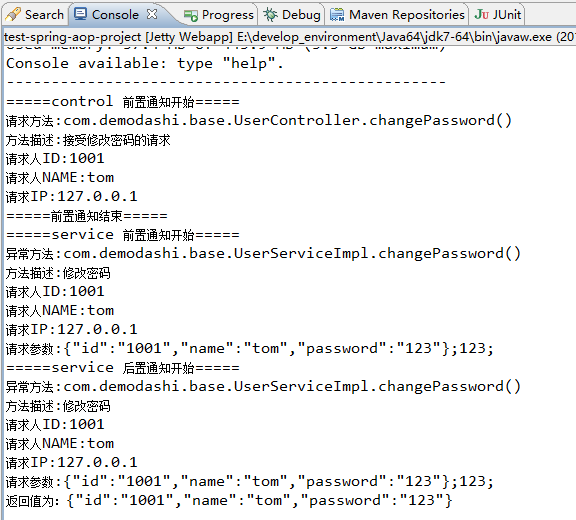概述
使用spring aop 来实现日志的统一收集功能
详细
使用spring aop 来实现日志的统一收集功能。
spring aop 配置
首先,我们定义2种注解,一种是给service用的,一种是给Controller用的。
给service使用的aop扫描
<aop:aspectj-autoproxy /> <context:annotation-config /> <context:component-scan base-package="com.demodashi"> <context:exclude-filter type="annotation" expression="org.springframework.stereotype.Controller" /> </context:component-scan> <tx:annotation-driven />
给Controller使用的aop扫描
<aop:aspectj-autoproxy /> <aop:aspectj-autoproxy proxy-target-class="true" /> <!-- 扫描web包,应用Spring的注解 --> <context:component-scan base-package="com.demodashi"> <context:include-filter type="annotation" expression="org.springframework.stereotype.Controller" /> <context:exclude-filter type="annotation" expression="javax.inject.Named" /> <context:exclude-filter type="annotation" expression="javax.inject.Inject" /> </context:component-scan>
java实现
实现思路,先定义两个注解类,一个给service类用的,一个给从controller类用的,然后使用切面类,对这两个注解进行绑定监控。结果就是,当使用注解绑定某个service类或者controller类的某个方法时,这个切面类就能监控到,并且能获取到这个service方法的相关输入,输出参数等。这样,就能实现了aop日志了。
给controller使用的注解类
package com.demodashi.aop.annotation;
import java.lang.annotation.*;
/**
*自定义注解 拦截Controller
*/
@Target({ElementType.PARAMETER, ElementType.METHOD})
@Retention(RetentionPolicy.RUNTIME)
@Documented
public @interface ControllerLogAnnotation {
String description() default "";
}
给service使用的注解类
package com.demodashi.aop.annotation;
import java.lang.annotation.*;
/**
*自定义注解 拦截service
*/
@Target({ElementType.PARAMETER, ElementType.METHOD})
@Retention(RetentionPolicy.RUNTIME)
@Documented
public @interface ServiceLogAnnotation {
String description() default "";
}
日志切面类
package com.demodashi.aop;
import java.lang.reflect.Method;
import javax.servlet.http.HttpServletRequest;
import javax.servlet.http.HttpSession;
import org.aspectj.lang.JoinPoint;
import org.aspectj.lang.annotation.AfterReturning;
import org.aspectj.lang.annotation.AfterThrowing;
import org.aspectj.lang.annotation.Aspect;
import org.aspectj.lang.annotation.Before;
import org.aspectj.lang.annotation.Pointcut;
import org.slf4j.Logger;
import org.slf4j.LoggerFactory;
import org.springframework.stereotype.Component;
import org.springframework.web.context.request.RequestContextHolder;
import org.springframework.web.context.request.ServletRequestAttributes;
import com.alibaba.fastjson.JSONObject;
import com.demodashi.aop.annotation.ControllerLogAnnotation;
import com.demodashi.aop.annotation.ServiceLogAnnotation;
import com.demodashi.base.UserVO;
/**
* 切点类
* @author xgchen
*
*/
@Aspect
@Component
public class SystemLogAspect {
public SystemLogAspect(){
}
//本地异常日志记录对象
private static final Logger logger = LoggerFactory.getLogger(SystemLogAspect.class);
//Service层切点
@Pointcut("@annotation(com.demodashi.aop.annotation.ServiceLogAnnotation)")
public void serviceAspect() {
}
//Controller层切点
@Pointcut("@annotation(com.demodashi.aop.annotation.ControllerLogAnnotation)")
public void controllerAspect() {
}
/**
* 前置通知 用于拦截Controller层记录用户的操作
*
* @param joinPoint 切点
*/
@Before("controllerAspect()")
public void doBefore4control(JoinPoint joinPoint) {
HttpServletRequest request = ((ServletRequestAttributes) RequestContextHolder.getRequestAttributes()).getRequest();
HttpSession session = request.getSession();
//读取session中的用户
UserVO user = (UserVO) session.getAttribute("USER");
//请求的IP
String ip = request.getRemoteAddr();
try {
//*========控制台输出=========*//
System.out.println("=====control 前置通知开始=====");
System.out.println("请求方法:" + (joinPoint.getTarget().getClass().getName() + "." + joinPoint.getSignature().getName() + "()"));
System.out.println("方法描述:" + getControllerMethodDescription(joinPoint));
System.out.println("请求人ID:" + user.getId());
System.out.println("请求人NAME:" + user.getName());
System.out.println("请求IP:" + ip);
System.out.println("=====前置通知结束=====");
} catch (Exception e) {
//记录本地异常日志
logger.error("==前置通知异常==");
logger.error("异常信息:{}", e.getMessage());
}
}
@Before("serviceAspect()")
public void doBefore4service(JoinPoint joinPoint) {
HttpServletRequest request = ((ServletRequestAttributes) RequestContextHolder.getRequestAttributes()).getRequest();
HttpSession session = request.getSession();
//读取session中的用户
UserVO user = (UserVO) session.getAttribute("USER");
//获取请求ip
String ip = request.getRemoteAddr();
//获取用户请求方法的参数并序列化为JSON格式字符串
String params = "";
if (joinPoint.getArgs() != null && joinPoint.getArgs().length > 0) {
for ( int i = 0; i < joinPoint.getArgs().length; i++) {
params += JSONObject.toJSON(joinPoint.getArgs()[i]).toString() + ";";
}
}
try {
/*========控制台输出=========*/
System.out.println("=====service 前置通知开始=====");
System.out.println("异常方法:" + (joinPoint.getTarget().getClass().getName() + "." + joinPoint.getSignature().getName() + "()"));
System.out.println("方法描述:" + getServiceMthodDescription(joinPoint));
System.out.println("请求人ID:" + user.getId());
System.out.println("请求人NAME:" + user.getName());
System.out.println("请求IP:" + ip);
System.out.println("请求参数:" + params);
} catch (Exception ex) {
//记录本地异常日志
logger.error("==异常通知异常==");
logger.error("异常信息:{}", ex.getMessage());
}
}
@AfterReturning(pointcut="serviceAspect()", returning="returnValue")
public void after4service(JoinPoint joinPoint, Object returnValue) {
HttpServletRequest request = ((ServletRequestAttributes) RequestContextHolder.getRequestAttributes()).getRequest();
HttpSession session = request.getSession();
//读取session中的用户
UserVO user = (UserVO) session.getAttribute("USER");
//获取请求ip
String ip = request.getRemoteAddr();
//获取用户请求方法的参数并序列化为JSON格式字符串
String params = "";
if (joinPoint.getArgs() != null && joinPoint.getArgs().length > 0) {
for ( int i = 0; i < joinPoint.getArgs().length; i++) {
params += JSONObject.toJSON(joinPoint.getArgs()[i]).toString() + ";";
}
}
try {
/*========控制台输出=========*/
System.out.println("=====service 后置通知开始=====");
System.out.println("异常方法:" + (joinPoint.getTarget().getClass().getName() + "." + joinPoint.getSignature().getName() + "()"));
System.out.println("方法描述:" + getServiceMthodDescription(joinPoint));
System.out.println("请求人ID:" + user.getId());
System.out.println("请求人NAME:" + user.getName());
System.out.println("请求IP:" + ip);
System.out.println("请求参数:" + params);
System.out.println("返回值为:" + JSONObject.toJSON(returnValue).toString());
} catch (Exception ex) {
//记录本地异常日志
logger.error("==异常通知异常==");
logger.error("异常信息:{}", ex.getMessage());
}
}
/**
* 异常通知 用于拦截service层记录异常日志
*
* @param joinPoint
* @param e
*/
@AfterThrowing(pointcut = "serviceAspect()", throwing = "e")
public void doAfterThrowing(JoinPoint joinPoint, Throwable e) {
HttpServletRequest request = ((ServletRequestAttributes) RequestContextHolder.getRequestAttributes()).getRequest();
HttpSession session = request.getSession();
//读取session中的用户
UserVO user = (UserVO) session.getAttribute("USER");
//获取请求ip
String ip = request.getRemoteAddr();
//获取用户请求方法的参数并序列化为JSON格式字符串
String params = "";
if (joinPoint.getArgs() != null && joinPoint.getArgs().length > 0) {
for ( int i = 0; i < joinPoint.getArgs().length; i++) {
params += JSONObject.toJSON(joinPoint.getArgs()[i]).toString() + ";";
}
}
try {
/*========控制台输出=========*/
System.out.println("=====异常通知开始=====");
System.out.println("异常代码:" + e.getClass().getName());
System.out.println("异常信息:" + e.getMessage());
System.out.println("异常方法:" + (joinPoint.getTarget().getClass().getName() + "." + joinPoint.getSignature().getName() + "()"));
System.out.println("方法描述:" + getServiceMthodDescription(joinPoint));
System.out.println("请求人ID:" + user.getId());
System.out.println("请求人NAME:" + user.getName());
System.out.println("请求IP:" + ip);
System.out.println("请求参数:" + params);
System.out.println("=====异常通知结束=====");
} catch (Exception ex) {
//记录本地异常日志
logger.error("==异常通知异常==");
logger.error("异常信息:{}", ex.getMessage());
}
/*==========记录本地异常日志==========*/
logger.error("异常方法:{}异常代码:{}异常信息:{}参数:{}", joinPoint.getTarget().getClass().getName() + joinPoint.getSignature().getName(), e.getClass().getName(), e.getMessage(), params);
}
/**
* 获取注解中对方法的描述信息 用于service层注解
*
* @param joinPoint 切点
* @return 方法描述
* @throws Exception
*/
public static String getServiceMthodDescription(JoinPoint joinPoint)
throws Exception {
String targetName = joinPoint.getTarget().getClass().getName();
String methodName = joinPoint.getSignature().getName();
Object[] arguments = joinPoint.getArgs();
Class targetClass = Class.forName(targetName);
Method[] methods = targetClass.getMethods();
String description = "";
for (Method method : methods) {
if (method.getName().equals(methodName)) {
Class[] clazzs = method.getParameterTypes();
if (clazzs.length == arguments.length) {
description = method.getAnnotation(ServiceLogAnnotation. class).description();
break;
}
}
}
return description;
}
/**
* 获取注解中对方法的描述信息 用于Controller层注解
*
* @param joinPoint 切点
* @return 方法描述
* @throws Exception
*/
public static String getControllerMethodDescription(JoinPoint joinPoint) throws Exception {
String targetName = joinPoint.getTarget().getClass().getName();
String methodName = joinPoint.getSignature().getName();
Object[] arguments = joinPoint.getArgs();
Class targetClass = Class.forName(targetName);
Method[] methods = targetClass.getMethods();
String description = "";
for (Method method : methods) {
if (method.getName().equals(methodName)) {
Class[] clazzs = method.getParameterTypes();
if (clazzs.length == arguments.length) {
description = method.getAnnotation(ControllerLogAnnotation. class).description();
break;
}
}
}
return description;
}
}
aop使用
就是将注解绑定到具体的service方法上面,或者control方法,如下所示:
@ServiceLogAnnotation(description = "修改密码")
@Override
public UserVO changePassword(UserVO vo, String newPassword) {
vo.setPassword(newPassword);
return vo;
}
@ResponseBody
@RequestMapping("/editPassword.do")
@ControllerLogAnnotation(description = "接受修改密码的请求")
public Map changePassword(ModelMap modelMap, HttpServletRequest request,
HttpServletResponse response) throws IOException {
String message = null;
String result = null;
Object vo = request.getSession().getAttribute("USER");
if (vo == null) {
message = "操作失败:对象不能为空!";
} else if (StringUtils.isBlank(request.getParameter("newPassword"))) {
message = "新登陆密码不能为空!";
}
if (message == null) {
try {
userApplication.changePassword((UserVO)vo, request.getParameter("newPassword"));
message = "修改成功!";
result = ConstantBean.SUCCESS;
} catch (Exception e) {
message = e.getMessage();
result = ConstantBean.SYSERR;
}
} else {
result = ConstantBean.SYSERR;
}
return toMap("data", message, "result", result);
}
运行起来
首把demo导入到eclipse后,运行的界面如下:

用户名 1001 密码 123
登陆后,修改密码,则看到eclipse控制台打印如下信息:

这样一个aop收集日志的功能了,这样的方式比直接把log写在具体的方法上要强多了,收集起来的log,可以直接写在本地,也可以接入elk方案。
接入elk方案可以参考本网站中的:《ELK + kafka 日志方案》